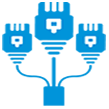Core areas of our solutions
Network Security Solutions
Our solutions encompass a set of technologies, processes, and practices designed to protect a computer network from unauthorized access, data breaches, cyber-attacks, and other security threats.
Key Components of Network Security Solutions.
Firewalls. This act as a barrier between a trusted internal network and untrusted external networks (like the internet).
Intrusion Detection and Prevention Systems (IDPS): IDPS continuously monitor network traffic, analyzing it for suspicious patterns and behaviors.
Virtual Private Networks (VPNs): VPNs provide secure, encrypted connections between remote users or branch offices and the corporate network.
Distributed Denial of Service (DDoS) Protection: DDoS protection solutions help mitigate the impact of DDoS attacks by identifying and filtering out malicious traffic, ensuring that legitimate traffic can still access the network resources.
Benefits of Network Security Solutions:
- Data Protection: Network security solutions safeguard sensitive data from unauthorized access, reducing the risk of data breaches and theft.
- Improved Productivity: By protecting the network from cyber threats,you can ensure uninterrupted operations, minimizing downtime and improving productivity.
- Regulatory Compliance: Implementing network security solutions helps you comply with industry regulations and data protection laws.
- Business Continuity: Robust network security measures contribute to maintaining business continuity even in the face of cyber-attacks or other security incidents.
- Enhanced Customer Trust: Customers and clients gain confidence in an organization that demonstrates a commitment to network security, protecting their sensitive information.
Data Center Infrastructure Solution
A well-implemented data center infrastructure solution is essential for organizations seeking to manage their IT resources efficiently, achieve high performance and availability.
Key Components of Data Center Infrastructure Solutions:
- Servers form the backbone of any data center infrastructure.
- Storage Systems: Data centers require robust storage solutions to store and manage vast amounts of data.
- Networking Equipment: Networking equipment is essential to connect servers, storage, and other components within the data center.
- Virtualization and Cloud Technologies: Virtualization technology enables the efficient utilization of computing resources by creating virtual instances of servers and operating systems.
Benefits of Data Center Infrastructure Solutions:
- Reliability and Uptime: A well-designed data center infrastructure solution ensures high availability and minimal downtime, crucial for businesses.
- Scalability: Data center solutions are designed to accommodate future growth and increased computing demands.
- Improved Efficiency: Data center infrastructure solutions optimize resource utilization, cooling efficiency, and power consumption, leading to cost savings.
- Centralized Management: Data centers provide a centralized platform for managing and monitoring the entire IT infrastructure, simplifying administrative tasks and improving overall IT governance.
User Security Solutions
User security solutions play a crucial role in protecting organizations from security risks arising from human error, insider threats, and social engineering attacks.
Helps us focus on safeguarding an organization’s IT systems, data, and sensitive information by addressing security risks related to employees and end-users.
Key Components and Practices:
- Key Components and Practices.
- Multi-Factor Authentication (MFA)
- Role-Based Access Control (RBAC).
- Account Monitoring and Anomaly Detection
- Data Loss Prevention (DLP): DLP solutions help prevent accidental or intentional data leaks by monitoring and controlling the movement of sensitive information.
Benefits:
- Reduced Security Incidents: User security solutions increase user awareness and knowledge, reducing the likelihood of falling victim to social engineering attacks.
- Data Protection: By implementing access controls, monitoring, and data loss prevention measures, user security solutions protect sensitive information from unauthorized access and disclosure.
- Increased Resilience: Robust user security practices improve an organization’s resilience against cyber threats.
- Compliance and Regulation: User security solutions assist you in meeting compliance requirements by enforcing security policies and protecting sensitive data.
- Improved Incident Response: With better user security measures in place, you can detect security incidents earlier and respond promptly.
